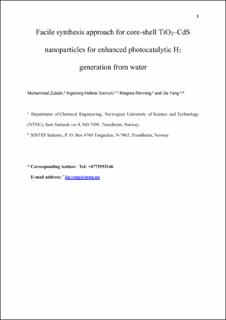Facile synthesis approach for core-shell TiO2–CdS nanoparticles for enhanced photocatalytic H2 generation from water
Peer reviewed, Journal article
Accepted version
Permanent lenke
https://hdl.handle.net/11250/2721034Utgivelsesdato
2018Metadata
Vis full innførselSamlinger
- Publikasjoner fra CRIStin - SINTEF AS [5801]
- SINTEF Industri [1566]
Originalversjon
10.1016/j.cattod.2018.10.070Sammendrag
With the ambition to design a cost-effective and highly stable photocatalyst with improved photocatalytic activity towards H2 generation by water splitting, herein we report a two-step facile synthesis approach for core-shell structure of TiO2-CdS nanocomposites. The synthesized photocatalysts are comprehensively characterized by SEM, XRD, BET, UV–vis DRS, Photoluminescence and XPS to investigate the morphological, crystalline, structural, optical properties and surface analysis. The photocatalytic activity is evaluated by measuring the ability of TiO2-CdS to generate H2 gas by water splitting in the presence of hole scavengers under simulated solar light at AM 1.5G conditions. Our optimized sample TiO2-CdS (3:2) exhibited an enhanced photocatalytic activity by generating 954 μmol g−1 h-1 of hydrogen which is ∼1.4 and ∼1.7 times higher than pure CdS nanoparticles and pure TiO2, respectively. The optimized sample achieved an apparent quantum efficiency of 3.53% along with good stability by generating a similar amount of H2 for 40 consecutive hours. The enhanced photocatalytic activity and stability of the core-shell TiO2-CdS nanocomposite is attributed to the broader solar spectrum absorption, efficient photo-induced charge separation on the interface of TiO2-CdS due to the formation of heterojunction and high surface area with a large fraction of mesopores.

